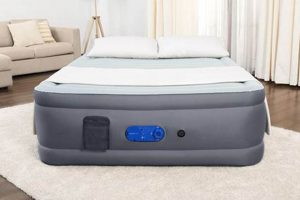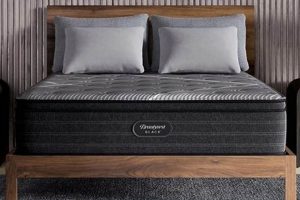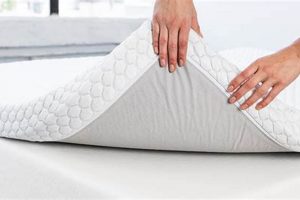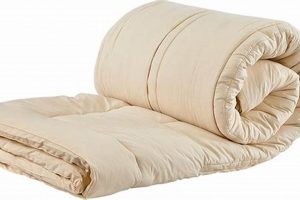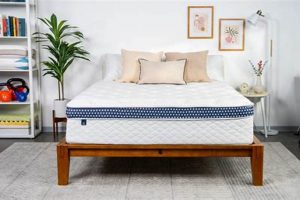A sleeping surface designed to provide consistent firmness and stability across its entire area, including the perimeter, is a key factor in optimizing sleep quality. This construction prevents sagging or collapsing when weight is applied near the sides. A practical example is a bed that allows individuals to sit comfortably on the edge without significant compression, thereby facilitating dressing or providing a stable surface for other activities.
The significance of this feature extends to improved sleep posture, maximized usable surface area, and increased overall durability. Individuals can utilize the full width of the bed without feeling like they might roll off, and couples experience less motion transfer. Historically, innovations in mattress construction have gradually addressed the issue of edge support, moving from simple coil systems to more complex reinforced designs that incorporate specialized foam or edge-to-edge support coils.
The following discussion will delve into specific types of mattress construction that enhance this attribute, examine materials commonly used to achieve it, and analyze the factors to consider when selecting a sleeping surface with superior perimeter reinforcement.
Optimizing Mattress Edge Performance
The subsequent guidelines offer valuable insights into evaluating and selecting a mattress engineered to deliver robust perimeter support. Adherence to these principles promotes informed decision-making.
Tip 1: Prioritize Reinforced Edge Construction: Examine mattress specifications for terms like “reinforced edge,” “edge support system,” or “encased coil edge.” These designations indicate deliberate engineering to prevent perimeter collapse.
Tip 2: Assess Material Density: High-density foam or tightly packed coils along the edges contribute significantly to structural integrity. Inquire about the density ratings of materials used in the perimeter.
Tip 3: Evaluate Edge Firmness: Physically test the edge by sitting or applying pressure to determine its resistance to compression. Ideally, the edge should exhibit similar firmness to the central sleeping surface.
Tip 4: Consider Hybrid Designs: Hybrid mattresses that combine innerspring cores with foam layers often incorporate specific edge support elements within the coil system or foam encasement.
Tip 5: Research Brand Reputation: Reputable mattress manufacturers often invest in research and development to improve edge support performance. Investigate customer reviews and expert opinions on brands known for robust construction.
Tip 6: Inspect Edge Quilt Patterns: Look for tightly stitched or reinforced quilting patterns along the perimeter. These patterns provide additional structural support and prevent material shifting.
Tip 7: Verify Warranty Coverage: Review the mattress warranty to ascertain whether edge sagging or collapse is covered. Comprehensive warranties provide recourse in case of premature deterioration.
Implementing these guidelines facilitates the selection of a sleep surface that not only provides optimal comfort but also maintains structural integrity and expands usable sleep space.
The concluding section of this discourse will synthesize the key principles discussed, providing a cohesive understanding of the characteristics and advantages of a well-engineered sleep solution.
1. Reinforced Perimeter Construction
Reinforced perimeter construction is a foundational element of a mattress designed to offer optimal edge support. The presence or absence of this feature directly dictates the mattress’s ability to maintain its structural integrity along its edges over time. A mattress lacking adequate reinforcement around its perimeter is prone to sagging and compression, thereby diminishing the usable sleeping surface and potentially accelerating overall wear. This design principle represents a proactive approach to extending the lifespan of the mattress while enhancing user experience.
Consider, for example, a mattress featuring a traditional coil system without any edge reinforcement. When an individual sits on the edge to dress, the coils near the periphery will likely compress excessively, creating a noticeable dip. This localized stress not only compromises the comfort but also gradually weakens the surrounding structure. In contrast, a mattress incorporating a high-density foam encasement or strategically placed, firmer coils along the edges distributes the weight more evenly, preventing excessive compression and maintaining a level surface. The practical significance lies in providing a stable edge for sitting, maximizing the usable sleeping area, and reducing motion transfer for couples.
In summary, reinforced perimeter construction is not merely an ancillary attribute; it is an indispensable component of a mattress intended to provide superior edge support. Its implementation directly impacts the mattress’s longevity, usability, and overall performance. Understanding this connection is crucial for consumers seeking a durable and comfortable sleep solution that withstands the demands of regular use and preserves its structural integrity over an extended period.
2. High-Density Edge Foam
High-density edge foam directly contributes to the overall performance and longevity of a mattress designed for superior edge support. This component, typically comprising polyurethane or memory foam with elevated density specifications, is strategically positioned along the perimeter to counteract compression and prevent sagging. The presence of high-density foam acts as a robust barrier, resisting deformation when weight is applied to the edge of the mattress. This, in turn, maintains a consistent sleeping surface and prevents the sensation of rolling off, factors critical for uninterrupted sleep.
The causal relationship between high-density edge foam and enhanced support is evident in its material properties. Denser foam formulations exhibit greater resistance to compression forces compared to lower-density alternatives. The result is a more stable and reliable edge, suitable for individuals who frequently sit on the side of the bed or require maximum utilization of the sleep surface. For example, a mattress with a standard foam edge may exhibit noticeable sagging after a few months of use, whereas one incorporating high-density foam retains its shape and structural integrity for an extended period. This performance differential directly influences user satisfaction and the perceived value of the product.
In summary, high-density edge foam is an indispensable element for a mattress seeking to deliver optimal edge support. Its material properties and strategic placement work synergistically to prevent sagging, maximize usable sleeping surface, and contribute to the overall durability of the mattress. The investment
in high-density materials is a critical factor for consumers who prioritize long-term comfort and structural integrity in their sleep solutions. The selection of mattresses with adequately reinforced edges offers a distinct advantage in terms of sleep quality and product lifespan, mitigating the challenges associated with premature wear and compromised sleeping surfaces.
3. Stable Sitting Edge
A stable sitting edge is a defining characteristic of a mattress designed with superior perimeter support. This feature refers to the firmness and lack of compression exhibited along the mattress’s border when subjected to the weight of a seated individual. Mattresses lacking this attribute often demonstrate significant sagging or collapse when someone sits on the edge, rendering the periphery unusable and potentially leading to structural damage over time. The presence of a stable sitting edge directly impacts usability, durability, and the overall value proposition of a mattress.
The implementation of edge support systems, such as reinforced coils or high-density foam encasements, is the primary means of achieving a stable sitting edge. For example, a mattress employing an edge-to-edge coil system with firmer gauge coils along the perimeter will distribute weight more effectively compared to a mattress with a standard coil system and minimal edge reinforcement. Consider a scenario where an individual regularly sits on the edge of their mattress to put on shoes. A mattress with a stable sitting edge will maintain its shape and provide a comfortable and supportive surface, whereas a mattress lacking this feature will gradually deform, reducing its usable lifespan and causing discomfort. This difference highlights the practical significance of a well-engineered edge support system.
In summary, a stable sitting edge is not merely a cosmetic feature; it is an indicator of robust construction and thoughtful design. Mattresses offering this attribute demonstrate a commitment to durability, usability, and long-term customer satisfaction. The ability to provide consistent support across the entire sleeping surface, including the edge, is a hallmark of a high-quality mattress and a crucial consideration for consumers seeking a durable and comfortable sleep solution. The integration of effective edge support mechanisms addresses a common point of failure in conventional mattresses, thereby enhancing their longevity and overall performance.
4. Reduced Motion Transfer
Edge support significantly influences motion isolation within a mattress system. A perimeter that readily compresses transmits movement across the sleeping surface more effectively. Conversely, a mattress engineered with robust edge support minimizes this transfer. This reduction occurs because a firm, stable edge restricts the propagation of disturbances originating from one side of the bed to the other. A mattress with deficient edge support permits more significant sinking and bouncing, which inherently amplifies motion transfer. In contrast, an effectively supported edge acts as a buffer, absorbing and dampening movement before it can travel across the surface.
Consider a scenario involving two individuals sharing a bed. One partner is prone to tossing and turning during the night. On a mattress with poor edge support, the movements of the restless sleeper will be readily felt by their partner, potentially disrupting their sleep. However, if the mattress possesses enhanced edge support, the firmer perimeter will limit the extent to which these movements translate into disturbances felt by the other sleeper. This improved motion isolation is a direct consequence of the edge support system’s ability to maintain consistent surface tension and prevent excessive compression in localized areas. Furthermore, the enhanced stability along the edges decreases the likelihood of one sleeper rolling towards the center of the bed due to a lack of support near the perimeter.
In summation, the relationship between edge support and motion transfer is causal and impactful. Superior edge support is not merely an ancillary feature; it is a crucial component for achieving effective motion isolation. Mattresses with robust edge systems provide a more stable and undisturbed sleep environment, particularly beneficial for couples or individuals sensitive to movement during the night. The practical significance of this understanding lies in facilitating informed purchasing decisions, enabling consumers to select mattresses that prioritize both edge support and reduced motion transfer for optimal sleep quality.
5. Extended Mattress Lifespan
The correlation between robust edge support and prolonged mattress durability is a significant consideration in the selection of a sleeping surface. A mattress experiencing premature edge degradation diminishes its overall lifespan and impacts the user’s investment. Effective edge support mitigates stress concentration and contributes to the sustained integrity of the mattress structure.
- Prevention of Edge Sagging
Edge sagging is a common cause of mattress deterioration. Consistent weight application near the perimeter, whether through sitting or sleeping, can cause the edges to compress and lose their original shape. A mattress with reinforced edge support distributes weight more evenly, preventing localized stress and minimizing the risk of sagging. This proactive measure directly translates to an extended period of usability and prevents premature replacement.
- Uniform Wear Distribution
Mattress wear is not always uniform; certain areas, such as the center or edges, may experience more stress than others. By providing consistent support across the entire surface, a well-engineered edge support system ensures that the mattress wears more evenly. This prevents the formation of localized indentations or soft spots, thereby contributing to a longer lifespan. For instance, a mattress without sufficient edge reinforcement may develop a noticeable dip along the sides within a few years, while one with robust support maintains its shape and provides consistent comfort for a longer period.
- Structural Integrity Preservation
The internal structure of a mattress, including coils, foam layers, and support systems, is vulnerable to damage from repeated compression and stress. Edge support systems provide additional reinforcement to these internal components, protecting them from excessive strain. This protection is particularly crucial for hybrid and innerspring mattresses, where edge integrity directly impacts the stability and performance of the entire support system. A mattress with enhanced edge support exhibits greater resistance to structural degradation, resulting in a prolonged lifespan.
- Minimization of Motion Transfer Effects
Motion transfer, the transmission of movement across the sleeping surface, can contribute to mattress wear by creating uneven stress distribution. Robust edge support limits motion transfer, preventing localized areas from experiencing excessive compression and strain. This minimization of motion-related stress contributes to the preservation of the mattres
s’s structural integrity and extends its overall lifespan. A mattress with effective edge support provides a more stable and consistent sleeping surface, reducing the risk of premature wear and tear.
The integration of effective edge support mechanisms directly influences the lifespan of a mattress. By preventing edge sagging, ensuring uniform wear distribution, preserving structural integrity, and minimizing motion transfer effects, a mattress with superior edge support delivers extended usability and a greater return on investment. Consumers prioritizing long-term value should carefully consider edge support as a critical factor in their mattress selection.
Frequently Asked Questions
This section addresses common inquiries regarding edge support in mattresses, providing factual and objective information to facilitate informed decision-making.
Question 1: What defines acceptable edge support in a mattress?
Acceptable edge support is characterized by minimal compression and consistent firmness along the mattress perimeter. It allows for comfortable sitting and prevents the sensation of rolling off the edge during sleep. A well-supported edge maintains its shape under pressure, contributing to overall stability.
Question 2: How does edge support affect the usable sleeping surface?
Insufficient edge support reduces the usable sleeping surface. Sagging edges diminish the available area for comfortable sleep, particularly for individuals who sleep near the perimeter. Adequate edge support maximizes the sleep surface, ensuring full utilization of the mattress dimensions.
Question 3: What mattress types typically offer the best edge support?
Hybrid and innerspring mattresses, especially those incorporating reinforced edge coils or high-density foam encasements, generally provide the most robust edge support. These designs mitigate edge compression and maintain a stable perimeter.
Question 4: Can edge support impact mattress durability?
Yes, inadequate edge support accelerates mattress deterioration. Edges lacking reinforcement are prone to sagging and structural damage, reducing the overall lifespan of the mattress. Superior edge support distributes weight evenly, preventing premature wear and tear.
Question 5: How can edge support be assessed during mattress selection?
Edge support can be assessed by physically testing the mattress edge. Sitting on the perimeter should not result in significant compression or a feeling of instability. A visual inspection can reveal the presence of reinforced coils or high-density foam encasements, indicating dedicated edge support.
Question 6: Is edge support essential for all sleepers?
While beneficial for most sleepers, edge support is particularly important for individuals who share a bed, those who sit on the edge frequently, or those who tend to sleep near the perimeter. Adequate edge support ensures consistent comfort and prevents the sensation of rolling off the mattress.
In summary, edge support is a crucial element in mattress design, impacting usability, durability, and overall sleep quality. Evaluating edge support during mattress selection ensures a comfortable and long-lasting sleep solution.
The following section will delve into methods for enhancing edge support in existing mattresses.
Concluding Assessment
This examination has underscored the importance of perimeter reinforcement in achieving optimal sleep surface performance. A best edge support mattress offers demonstrable advantages in terms of usable space, structural longevity, and minimization of motion disturbance. Selection criteria should prioritize reinforced construction, high-density materials, and demonstrable stability under load. These factors directly impact the long-term value and effectiveness of the sleep solution.
The pursuit of a superior sleep environment necessitates a rigorous evaluation of mattress characteristics, with edge support representing a critical consideration. Ongoing advancements in materials science and mattress design promise further refinement of edge support technologies, offering consumers increasingly sophisticated options for enhancing sleep quality and overall well-being. The choice of a best edge support mattress remains a prudent investment in long-term comfort and sustained structural integrity.



